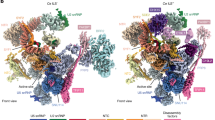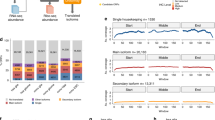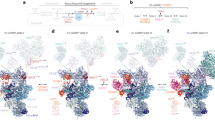Abstract
The precise excision of introns from pre-messenger RNA is performed by the spliceosome, a macromolecular machine containing five small nuclear RNAs and numerous proteins. Much has been learned about the protein components of the spliceosome from analysis of individual purified small nuclear ribonucleoproteins1 and salt-stable spliceosome ‘core’ particles2,3. However, the complete set of proteins that constitutes intact functional spliceosomes has yet to be identified. Here we use maltose-binding protein affinity chromatography4,5 to isolate spliceosomes in highly purified and functional form. Using nanoscale microcapillary liquid chromatography tandem mass spectrometry6, we identify ∼145 distinct spliceosomal proteins, making the spliceosome the most complex cellular machine so far characterized. Our spliceosomes comprise all previously known splicing factors and 58 newly identified components. The spliceosome contains at least 30 proteins with known or putative roles in gene expression steps other than splicing. This complexity may be required not only for splicing multi-intronic metazoan pre-messenger RNAs, but also for mediating the extensive coupling between splicing and other steps in gene expression.
This is a preview of subscription content, access via your institution
Access options
Subscribe to this journal
Receive 51 print issues and online access
$199.00 per year
only $3.90 per issue
Buy this article
- Purchase on SpringerLink
- Instant access to full article PDF
Prices may be subject to local taxes which are calculated during checkout


Similar content being viewed by others
References
Will, C. L. & Luhrmann, R. Spliceosomal UsnRNP biogenesis, structure and function. Curr. Opin. Cell Biol. 13, 290–301 (2001)
Neubauer, G. et al. Mass spectrometry and EST-database searching allows characterization of the multi-protein spliceosome complex. Nature Genet. 20, 46–50 (1998)
Bennett, M., Michaud, S., Kingston, J. & Reed, R. Protein components specifically associated with prespliceosome and spliceosome complexes. Genes Dev. 6, 1986–2000 (1992)
Zhou, Z. et al. The protein Aly links pre-messenger-RNA splicing to nuclear export in metazoans. Nature 407, 401–405 (2000)
Das, R., Zhou, Z. & Reed, R. Functional association of U2 snRNP with the ATP-independent spliceosomal complex E. Mol. Cell 5, 779–787 (2000)
Licklider, L. J., Thoreen, C. C., Peng, J. & Gygi, S. P. Automation of nanoscale microcapillary liquid chromatography-tandem mass spectrometry with a vented column. Anal. Chem. 74, 3076–3083 (2002)
Staley, J. P. & Guthrie, C. Mechanical devices of the spliceosome: motors, clocks, springs, and things. Cell 92, 315–326 (1998)
Burge, C. B., Tuschl, T. H. & Sharp, P. A. The RNA World (eds Gesteland, R. F., Cech, T. R. & Atkins, J. F.) 525–560 (Cold Spring Harbor Laboratory Press, New York, 1999)
Hastings, M. L. & Krainer, A. R. Pre-mRNA splicing in the new millennium. Curr. Opin. Cell Biol. 13, 302–309 (2001)
Bennett, M., Pinol-Roma, S., Staknis, D., Dreyfuss, G. & Reed, R. Differential binding of heterogeneous nuclear ribonucleoproteins to mRNA precursors prior to spliceosome assembly in vitro. Mol. Cell Biol. 12, 3165–3175 (1992)
Fu, X. D. The superfamily of arginine/serine-rich splicing factors. RNA 1, 663–680 (1995)
Tacke, R. & Manley, J. L. Determinants of SR protein specificity. Curr. Opin. Cell Biol. 11, 358–362 (1999)
Graveley, B. R. Sorting out the complexity of SR protein functions. RNA 6, 1197–1211 (2000)
Zhou, Z. & Reed, R. Human homologs of yeast prp16 and prp17 reveal conservation of the mechanism for catalytic step II of pre-mRNA splicing. EMBO J. 17, 2095–2106 (1998)
Reed, R. & Hurt, E. A conserved mRNA export machinery coupled to pre-mRNA splicing. Cell 108, 523–531 (2002)
Vithana, E. N. et al. A human homolog of yeast pre-mRNA splicing gene, PRP31, underlies autosomal dominant retinitis pigmentosa on chromosome 19q13.4 (RP11). Mol. Cell 8, 375–381 (2001)
Makarova, O. V., Makarov, E. M., Liu, S., Vornlocher, H. P. & Luhrmann, R. Protein 61K, encoded by a gene (PRPF31) linked to autosomal dominant retinitis pigmentosa, is required for U4/U6•U5 tri-snRNP formation and pre-mRNA splicing. EMBO J. 21, 1148–1157 (2002)
Chakarova, C. F. et al. Mutations in HPRP3, a third member of pre-mRNA splicing factor genes, implicated in autosomal dominant retinitis pigmentosa. Hum. Mol. Genet. 11, 87–92 (2002)
McKie, A. B. et al. Mutations in the pre-mRNA splicing factor gene PRPC8 in autosomal dominant retinitis pigmentosa (RP13). Hum. Mol. Genet. 10, 1555–1562 (2001)
Little, N. A., Hastie, N. D. & Davies, R. C. Identification of WTAP, a novel Wilms' tumour 1-associating protein. Hum. Mol. Genet. 9, 2231–2239 (2000)
Horowitz, D. S., Lee, E. J., Mabon, S. A. & Misteli, T. A cyclophilin functions in pre-mRNA splicing. EMBO J. 21, 470–480 (2002)
Andersen, J. S. et al. Directed proteomic analysis of the human nucleolus. Curr. Biol. 12, 1–11 (2002)
Stevens, S. W. et al. Composition and functional characterization of the yeast spliceosomal penta-snRNP. Mol. Cell 9, 31–44 (2002)
Cartegni, L., Chew, S. L. & Krainer, A. Listening to silence and understanding nonsense: Exonic mutations that affect splicing. Nature Rev. Genet. 3, 285–298 (2002)
Bentley, D. Coupling RNA polymerase II transcription with pre-mRNA processing. Curr. Opin. Cell Biol. 11, 347–351 (1999)
Hirose, Y. & Manley, J. L. RNA polymerase II and the integration of nuclear events. Genes Dev. 14, 1415–1429 (2000)
Maniatis, T. & Reed, R. An extensive network of coupling among gene expression machines. Nature 416, 499–506 (2002)
Fong, Y. W. & Zhou, Q. Stimulatory effect of splicing factors on transcriptional elongation. Nature 414, 929–933 (2001)
Strasser, K. et al. TREX is a conserved complex coupling transcription with messenger RNA export. Nature 417, 304–308 (2002)
Eng, J. K., McCormack, A. L. & Yates, J. R. An approach to correlate tandem mass spectral data of peptides with amino acid sequences in a protein database. J. Am. Soc. Mass Spectrom. 5, 976–989 (1994)
Acknowledgements
We thank. N. Dorman, E. Ibrahim and K. Magni for comments on the manuscript; C. Thoreen for database support; R. Das for SF3a-depleted nuclear extract; and R. Luhrmann and G. Dreyfuss for antibodies. HeLa cells were obtained from the National Cell Culture Center. This work was supported by the NIH (S.P.G. and R.R.).
Author information
Authors and Affiliations
Corresponding author
Ethics declarations
Competing interests
The authors declare that they have no competing financial interests.
Rights and permissions
About this article
Cite this article
Zhou, Z., Licklider, L., Gygi, S. et al. Comprehensive proteomic analysis of the human spliceosome. Nature 419, 182–185 (2002). https://doi.org/10.1038/nature01031
Received:
Accepted:
Issue Date:
DOI: https://doi.org/10.1038/nature01031
This article is cited by
-
SAF-A mutants disrupt chromatin structure through dominant negative effects on RNAs associated with chromatin
Mammalian Genome (2022)
-
DDX3X: structure, physiologic functions and cancer
Molecular Cancer (2021)
-
SPF45/RBM17-dependent, but not U2AF-dependent, splicing in a distinct subset of human short introns
Nature Communications (2021)
-
Role of FRG1 in predicting the overall survivability in cancers using multivariate based optimal model
Scientific Reports (2021)
-
The DEAD-box protein family of RNA helicases: sentinels for a myriad of cellular functions with emerging roles in tumorigenesis
International Journal of Clinical Oncology (2021)



